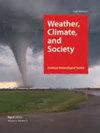超市零售价值链温室气体排放的计量与管理
IF 1.9
4区 地球科学
Q3 ENVIRONMENTAL STUDIES
引用次数: 0
摘要
这项研究量化了超市零售业整个价值链上间接活动的温室气体排放,以得出缓解措施。超市零售价值链的直接和间接温室气体排放源都是根据国家组织碳足迹估计指南确定和计算的,总面积为13248平方米,每天营业12小时。采用了一个评分矩阵,该矩阵考虑了排放量、影响程度以及与商业运营相关的风险或机遇。评分结果表明,任何温室气体分析都应包括价值链活动的主要贡献。计算显示,价值链活动产生的温室气体排放量为33784 tCO2e/年,占总排放量的94%。主要贡献者与采购商品的生产和食物浪费的管理有关。因此,在制定有效的温室气体管理战略时,不应忽视价值链活动。此外,应优先考虑购买带有碳减排标签的产品和服务,同时可以考虑应用人工智能和创新,以减少过期商品造成的食品浪费。本文章由计算机程序翻译,如有差异,请以英文原文为准。
Measurement and Management of Value Chain Greenhouse Gas Emissions from Supermarket Retailing
This study quantified greenhouse gas emissions from indirect activities along the whole value chain of supermarket retailing to derive mitigation measures. Both direct and indirect greenhouse gas emission sources of a supermarket retailing value chain were identified and calculated using the national guidelines for estimating the carbon footprint for organizations, based on a total area of 13,248 m2 and operating 12 hours per day. A scoring matrix was applied that considered the magnitude of emissions, the level of influence, and the risks or opportunities associated with the business operation. The scoring results indicated a major contribution from value chain activities that should be included in any greenhouse gas analysis. The calculation revealed that the greenhouse gas emissions from the value chain activities were 33,784 tCO2e/year or 94% of the total emissions. The key contributors were linked to the production of purchased goods and the management of food waste. Thus, value chain activities should not be overlooked in developing efficient greenhouse gas management strategies. Furthermore, purchased products and services carrying a carbon reduction label should be given priority, while the application of artificial intelligence and innovation could be considered to reduce the amount of food waste from expired goods.
求助全文
通过发布文献求助,成功后即可免费获取论文全文。
去求助
来源期刊

Weather Climate and Society
METEOROLOGY & ATMOSPHERIC SCIENCES-
CiteScore
3.40
自引率
13.60%
发文量
95
审稿时长
>12 weeks
期刊介绍:
Weather, Climate, and Society (WCAS) publishes research that encompasses economics, policy analysis, political science, history, and institutional, social, and behavioral scholarship relating to weather and climate, including climate change. Contributions must include original social science research, evidence-based analysis, and relevance to the interactions of weather and climate with society.
 求助内容:
求助内容: 应助结果提醒方式:
应助结果提醒方式:


